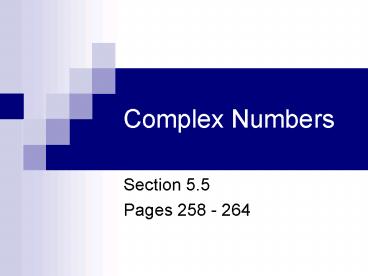Complex Numbers - PowerPoint PPT Presentation
1 / 12
Title:
Complex Numbers
Description:
Complex number plane: rectangular coordinate plane where the ... similar to multiplying binomials, use FOIL, vertical or horizontal methods, but remember, i*i=1 ... – PowerPoint PPT presentation
Number of Views:1280
Avg rating:3.0/5.0
Title: Complex Numbers
1
Complex Numbers
- Section 5.5
- Pages 258 - 264
2
Objectives
- Identify, add, subtract and multiply complex and
imaginary numbers.
3
Definitions
- Imaginary numbers numbers with v-1 (i) as a
factor v-25 5i - Complex numbers numbers that are the sum of a
real number and an imaginary number 73i - Complex number plane rectangular coordinate
plane where the real part of a complex number is
graphed on the horizontal axis and the imaginary
part is graphed on the vertical axis - Standard form a bi
4
Numbers
5
Operations With Complex Numbers
- Addition and subtraction add/subtract real
parts, then add/subtract imaginary parts - Multiplication similar to multiplying binomials,
use FOIL, vertical or horizontal methods, but
remember, ii1
6
Properties of Complex Numbers
- Associative
- Commutative
- Distributive
7
Real World Application
- Electrical Engineering
8
Imaginary Reactive
- Electrical engineers often use complex numbers to
represent electrical load on AC circuits. - The real part of the complex number represents
real load (KW) which corresponds to fuel costs - The imaginary part of the complex number
represents reactive load (KVAR)
9
The Load Formula
The load formula uses the real and reactive load
requirements to determine KVA. KVA is the basis
for equipment cost.
10
Power Factor
- The ratio of KW/KVA is called the power factor
and is often used to describe the load
requirements of a system. - When the reactive load is zero, KWKVA, the power
factor is one and the system is operating
efficiently. - Capacitors have no real load and a negative
reactive load. They are added to the system to
achieve a power factor of one.
11
Objectives
- Identify, add, subtract and multiply complex and
imaginary numbers.
12
Assignment
- Pages 262 - 263, problems 3, 6, 9, . . . , 66































